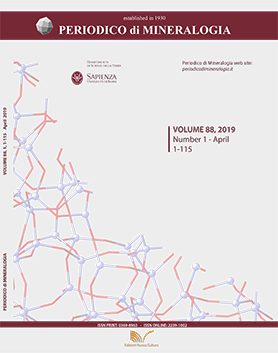Occurrence of albitite from Capo Malfatano, SW Sardinia: first report, characterization from mineralogy and whole-rock geochemistry
DOI:
https://doi.org/10.2451/2019PM830Keywords:
albitite, REE enrichment, Ordovician magmatism, SW SardiniaAbstract
Within the sedimentary-volcanoclastic succession known as Bithia Unit (SW Sardinia) a decameter-wide albitite lens has been found and is here characterized from a geological, petrographic and geochemical point of view. Albitite is a yellowish, fine-grained body elongated and foliated according to the main schistosity of the hosting rocks (N20-25° - 40° NW). The rock is made up by plagioclase porphyroclasts in a fine-grained matrix of plagioclase (up to 80%) and quartz; both porphyroclasts and small grains in matrix are almost pure albite (Ab98). Accessory phases are ilmenite, rutile, monazite, apatite and zircon. Bulk-rock chemical analyses show that the relative proportions of SiO2, Al2O3 and Na2O strongly resemble those of pure albite. Major, trace and rare earth element (REE) contents strongly suggest geochemical affinity with the nearby Ordovician metavolcanics and orthogneiss from Capo Malfatano area described in literature. Furthermore, REE, Rb/Sr, Y/Ho and Zr/Hf ratios seem to exclude the involvement of a significant Na-rich fluid metasomatism.
Downloads
Published
Issue
Section
License
Copyright (c) 2019 PERIODICO di MINERALOGIA

This work is licensed under a Creative Commons Attribution 4.0 International License.


